Ditapis dengan
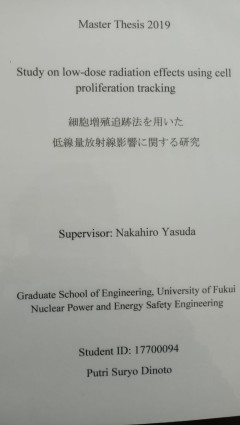
Study on low-dose radiation effects using cell proliferation tracking
Conclusion of this thesis: - Exposure effects in SF obtained by cell proliferation tracking system (more detail read on page 71) - Develop new approach to indicate radiation exposure effects on cells, that will be comparabale and more beneficial to traditional methods (More detail read on page 71)
- Edisi
- -
- ISBN/ISSN
- -
- Deskripsi Fisik
- 74p.;illus, 24cm
- Judul Seri
- -
- No. Panggil
- 621.4835 SUR S
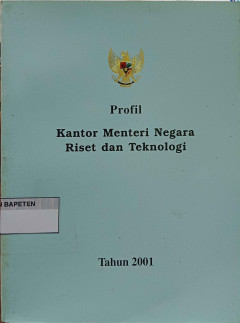
Profil Kantor Menteri Negara Riset dan Teknologi, Tahun 2001
Buku ini disusun dalam rangka memberikan informasi pendukung kelancaran pelaksanaan tugas sehari-hari aparatur Kantor Menteri Negara Riset dan Teknologi serta pihak-pihak terkait lainnya, sehingga dapat menjadi pedoman yang praktis sekaligus merupakan media publikasi profil Kantor Menteri Negara Riset dan Teknologi kepada instansi lain , masyarakat umum, pers, dll. (Jml)
- Edisi
- -
- ISBN/ISSN
- -
- Deskripsi Fisik
- 94 p. : Illus. ; 24 cm
- Judul Seri
- -
- No. Panggil
- 353 RIS P
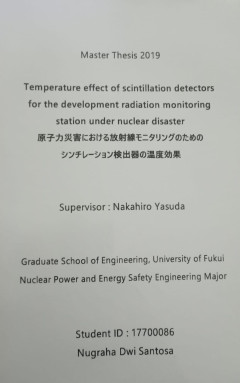
Temperature effect of scintillation detectors for the development radiation m…
This thesis about the use of scintillation detectors for radiation monitoring. Japan is one country that has many nuclear power plants. To ensure around nuclear power plants, it is necessary to build a radiation monitoring station. Radiation monitoring is carried out by measuring the air dose rate and radionuclide content. In the nuclear emergency disaster scenario, radiation monitoring is one …
- Edisi
- -
- ISBN/ISSN
- -
- Deskripsi Fisik
- 73p.;illus, 24cm
- Judul Seri
- -
- No. Panggil
- 358.39 DWI T
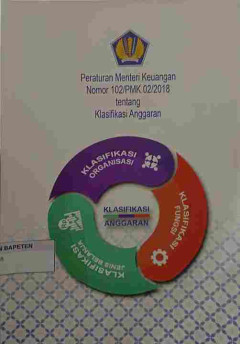
Peraturan Menteri Keuangan Nomor 102/PMK.02/2018 Tentang Klasifikasi Anggaran
Peraturan Menteri Keuangan Nomor 102/PMK.02/2018 Tentang Klasifikasi Anggaran ini berisi sebanyak 6 Bab, 10 Pasal. Ditetapkan oleh Menteri Keuangan RI Sri Mulyani Indrawati pada tanggal 28 Agustus 2018. (Jml)
- Edisi
- -
- ISBN/ISSN
- -
- Deskripsi Fisik
- 150 p. : Illus. ; 25 cm
- Judul Seri
- -
- No. Panggil
- 348.598 KEU P
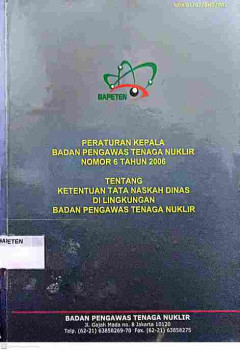
Peraturan Kepala Bapeten Nomor 6 Tahun 2006 Tentang Ketentuan Tata Naskah Din…
Berisi Peraturan Kepala BAPETEN Nomor 6 tahun 2006 Tentang Ketentuan Tata Naskah Dinas di Lingkungan Badan Pengawas Tenaga Nuklir, 3 Pasal ditetapkan tgl. November 2006 oleh Kepala BAPETEN Sukarman Aminjoyo. (Jml)
- Edisi
- -
- ISBN/ISSN
- -
- Deskripsi Fisik
- 58 p. : Illus. ; 24 cm
- Judul Seri
- Seri peraturan Kepala
- No. Panggil
- 348.598 BAD P
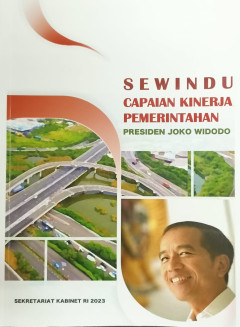
Sewindu Capaian Kinerja Pemerintahan Presiden Joko Widodo
Seperti apa kinerja Presiden Joko Widodo selama 8 tahun berjalan? Hasil apa saja yang dicapai untuk negara Indonesia? Inilah yang akan dibahas dalam buku Sewindu Capaian Kinerja Pemerintahan Presiden Joko Widodo. Ada banyak pokok bahasan utama di antaranya adalah indkator dari banyak sisi seperti ekonomi perencanaan pembangunan, data penerimaan pajak, capaian sektor jasa keuangan, realisasi inv…
- Edisi
- -
- ISBN/ISSN
- -
- Deskripsi Fisik
- 262p,;illus
- Judul Seri
- -
- No. Panggil
- 351 SEK S
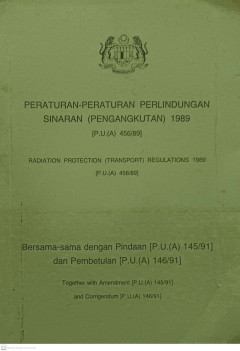
Peraturan-Peraturan Perlindungan Sinaran (Pengangkutan) 1989 [P.U.(A) 456/89 …
Buku ini membahas mengenai Peraturan-Peraturan tentang Perlindungan Radiasi pada Transportasi di Malaysia, diterbitkan pada tahun 1989 oleh Warta Kerajaan Seri Paduka Baginda.
- Edisi
- -
- ISBN/ISSN
- -
- Deskripsi Fisik
- 345 p. : illus. ; 25 cm
- Judul Seri
- -
- No. Panggil
- 342.595 MAL P

Pedoman Organisasi dan Tatalaksana Bagian II
Tujuan dari penyusunan pedoman organisasi tatalaksana bagian II ini adalah sebagai bentuk upaya mewujudkan organisasi yang baik serta sebagai salah satu referensi bagi penyusunan dan penetapan sistem manajemen mutu BAPETEN. . Buku ini terdiri dari 3 (tiha) jilid, untuk jilid kedua ini berisi kumpulan standar sistem manajemen atau jaminan mutu internasional, baik dari badan ISO maupun IAEA. (Jml)
- Edisi
- -
- ISBN/ISSN
- -
- Deskripsi Fisik
- vi, 268 p. : Illus. ; 30 cm
- Judul Seri
- Seri Laporan Teknis
- No. Panggil
- 061 BAP P (3)

Pedoman Organisasi dan Tata Laksana Bagian III
Tujuan dari penyusunan pedoman organisasi tatalaksana bagian III ini adalah sebagai bentuk upaya mewujudkan organisasi yang baik serta sebagai salah satu referensi bagi penyusunan dan penetapan sistem manajemen mutu BAPETEN. . Buku ini terdiri dari 3 (tiha) jilid, untuk jilid ketiga ini berisi ketentuan IAEA tentang kerangka hukum dan tanggungjawab pemerintah, fungsi dan wewenang badan pengawas…
- Edisi
- -
- ISBN/ISSN
- -
- Deskripsi Fisik
- v, 195 p. : Illus. ; 30 cm
- Judul Seri
- Seri Laporan Teknis
- No. Panggil
- 061 BAP P (2)
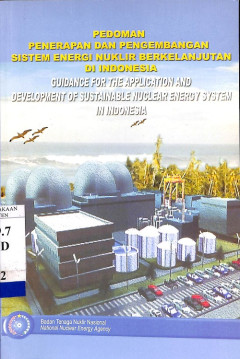
Pedoman Penerapan dan Pengembangan Sistem Energi Nuklir Berkelanjutan di Indo…
Sebagai pedoman bagi penerapan dan pengembangan Sistem Energi Nuklir (SEN) yang berkelanjutan sebagai bagian pasokan energi berkelanjutan guna mendukung pembangunan berkesinambungan. Pedoman ini berisi seperangkat prinsip dasar dan persyaratan dalam bidang ekonomi, lingkungan, keselamatan, pengelolaan limbah, resistansi proliferasi dan infrastruktur. (Jml)
- Edisi
- -
- ISBN/ISSN
- -
- Deskripsi Fisik
- iii, 132 p. : Illus. ; 24 cm
- Judul Seri
- -
- No. Panggil
- 539.7 BAT p
 Karya Umum
Karya Umum  Filsafat
Filsafat  Agama
Agama  Ilmu-ilmu Sosial
Ilmu-ilmu Sosial  Bahasa
Bahasa  Ilmu-ilmu Murni
Ilmu-ilmu Murni 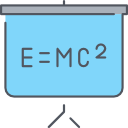 Ilmu-ilmu Terapan
Ilmu-ilmu Terapan  Kesenian, Hiburan, dan Olahraga
Kesenian, Hiburan, dan Olahraga  Kesusastraan
Kesusastraan  Geografi dan Sejarah
Geografi dan Sejarah